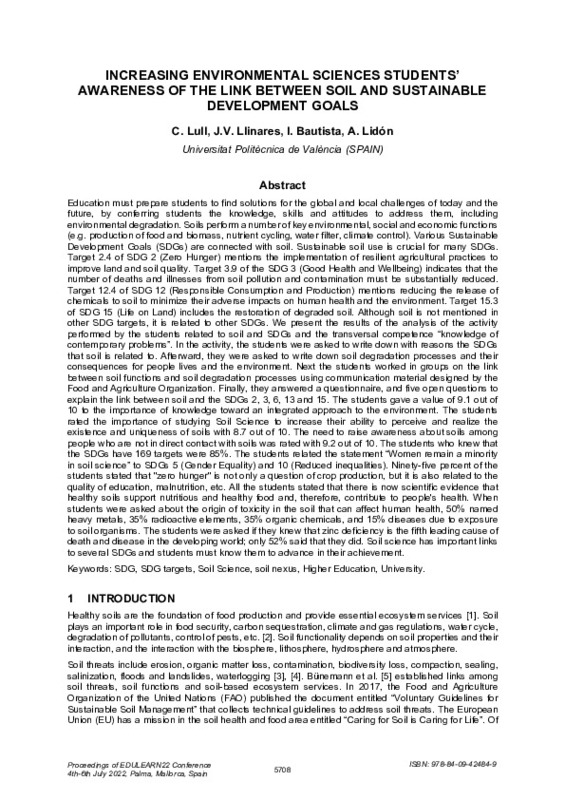JavaScript is disabled for your browser. Some features of this site may not work without it.
Buscar en RiuNet
Listar
Mi cuenta
Estadísticas
Ayuda RiuNet
Admin. UPV
Increasing environmental sciences students' awareness of the link between soil and Sustainable Development Goals
Mostrar el registro sencillo del ítem
Ficheros en el ítem
| dc.contributor.author | Lull, Cristina
|
es_ES |
| dc.contributor.author | Llinares Palacios, Josep Vicent
|
es_ES |
| dc.contributor.author | Bautista, Inmaculada
|
es_ES |
| dc.contributor.author | Lidón, Antonio
|
es_ES |
| dc.date.accessioned | 2022-09-01T08:02:13Z | |
| dc.date.available | 2022-09-01T08:02:13Z | |
| dc.date.issued | 2022-07-06 | es_ES |
| dc.identifier.isbn | 978-84-09-42484-9 | es_ES |
| dc.identifier.uri | http://hdl.handle.net/10251/185028 | |
| dc.description.abstract | [EN] Education must prepare students to find solutions for the global and local challenges of today and the future, by conferring students the knowledge, skills and attitudes to address them, including environmental degradation. Soils perform a number of key environmental, social and economic functions (e.g. production of food and biomass, nutrient cycling, water filter, climate control). Various Sustainable Development Goals (SDGs) are connected with soil. Sustainable soil use is crucial for many SDGs. Target 2.4 of SDG 2 (Zero Hunger) mentions the implementation of resilient agricultural practices to improve land and soil quality. Target 3.9 of the SDG 3 (Good Health and Wellbeing) indicates that the number of deaths and illnesses from soil pollution and contamination must be substantially reduced. Target 12.4 of SDG 12 (Responsible Consumption and Production) mentions reducing the release of chemicals to soil to minimize their adverse impacts on human health and the environment. Target 15.3 of SDG 15 (Life on Land) includes the restoration of degraded soil. Although soil is not mentioned in other SDG targets, it is related to other SDGs. We present the results of the analysis of the activity performed by the students related to soil and SDGs and the transversal competence ¿knowledge of contemporary problems¿. In the activity, the students were asked to write down with reasons the SDGs that soil is related to. Afterward, they were asked to write down soil degradation processes and their consequences for people lives and the environment. Next the students worked in groups on the link between soil functions and soil degradation processes using communication material designed by the Food and Agriculture Organization. Finally, they answered a questionnaire, and five open questions to explain the link between soil and the SDGs 2, 3, 6, 13 and 15. The students gave a value of 9.1 out of 10 to the importance of knowledge toward an integrated approach to the environment. The students rated the importance of studying Soil Science to increase their ability to perceive and realize the existence and uniqueness of soils with 8.7 out of 10. The need to raise awareness about soils among people who are not in direct contact with soils was rated with 9.2 out of 10. The students who knew that the SDGs have 169 targets were 85%. The students related the statement ¿Women remain a minority in soil science¿ to SDGs 5 (Gender Equality) and 10 (Reduced inequalities). Ninety-five percent of the students stated that "zero hunger" is not only a question of crop production, but it is also related to the quality of education, malnutrition, etc. All the students stated that there is now scientific evidence that healthy soils support nutritious and healthy food and, therefore, contribute to people's health. When students were asked about the origin of toxicity in the soil that can affect human health, 50% named heavy metals, 35% radioactive elements, 35% organic chemicals, and 15% diseases due to exposure to soil organisms. The students were asked if they knew that zinc deficiency is the fifth leading cause of death and disease in the developing world; only 52% said that they did. Soil science has important links to several SDGs and students must know them to advance in their achievement. | es_ES |
| dc.language | Inglés | es_ES |
| dc.publisher | IATED | es_ES |
| dc.relation.ispartof | EDULEARN22 Proceedings | es_ES |
| dc.rights | Reserva de todos los derechos | es_ES |
| dc.subject | SDG | es_ES |
| dc.subject | SDG targets | es_ES |
| dc.subject | Soil Science | es_ES |
| dc.subject | Soil nexus | es_ES |
| dc.subject | Higher Education | es_ES |
| dc.subject | University | es_ES |
| dc.subject.classification | EDAFOLOGIA Y QUIMICA AGRICOLA | es_ES |
| dc.title | Increasing environmental sciences students' awareness of the link between soil and Sustainable Development Goals | es_ES |
| dc.type | Comunicación en congreso | es_ES |
| dc.type | Capítulo de libro | es_ES |
| dc.identifier.doi | 10.21125/edulearn.2022.1344 | es_ES |
| dc.rights.accessRights | Abierto | es_ES |
| dc.contributor.affiliation | Universitat Politècnica de València. Departamento de Química - Departament de Química | es_ES |
| dc.description.bibliographicCitation | Lull, C.; Llinares Palacios, JV.; Bautista, I.; Lidón, A. (2022). Increasing environmental sciences students' awareness of the link between soil and Sustainable Development Goals. IATED. 5708-5717. https://doi.org/10.21125/edulearn.2022.1344 | es_ES |
| dc.description.accrualMethod | S | es_ES |
| dc.relation.conferencename | 14th International Conference on Education and New Learning Technologies (EDULEARN 2022) | es_ES |
| dc.relation.conferencedate | Julio 04-06,2022 | es_ES |
| dc.relation.conferenceplace | Palma de Mallorca, Spain | es_ES |
| dc.relation.publisherversion | https://doi.org/10.21125/edulearn.2022.1344 | es_ES |
| dc.description.upvformatpinicio | 5708 | es_ES |
| dc.description.upvformatpfin | 5717 | es_ES |
| dc.type.version | info:eu-repo/semantics/publishedVersion | es_ES |
| dc.relation.pasarela | S\468954 | es_ES |








